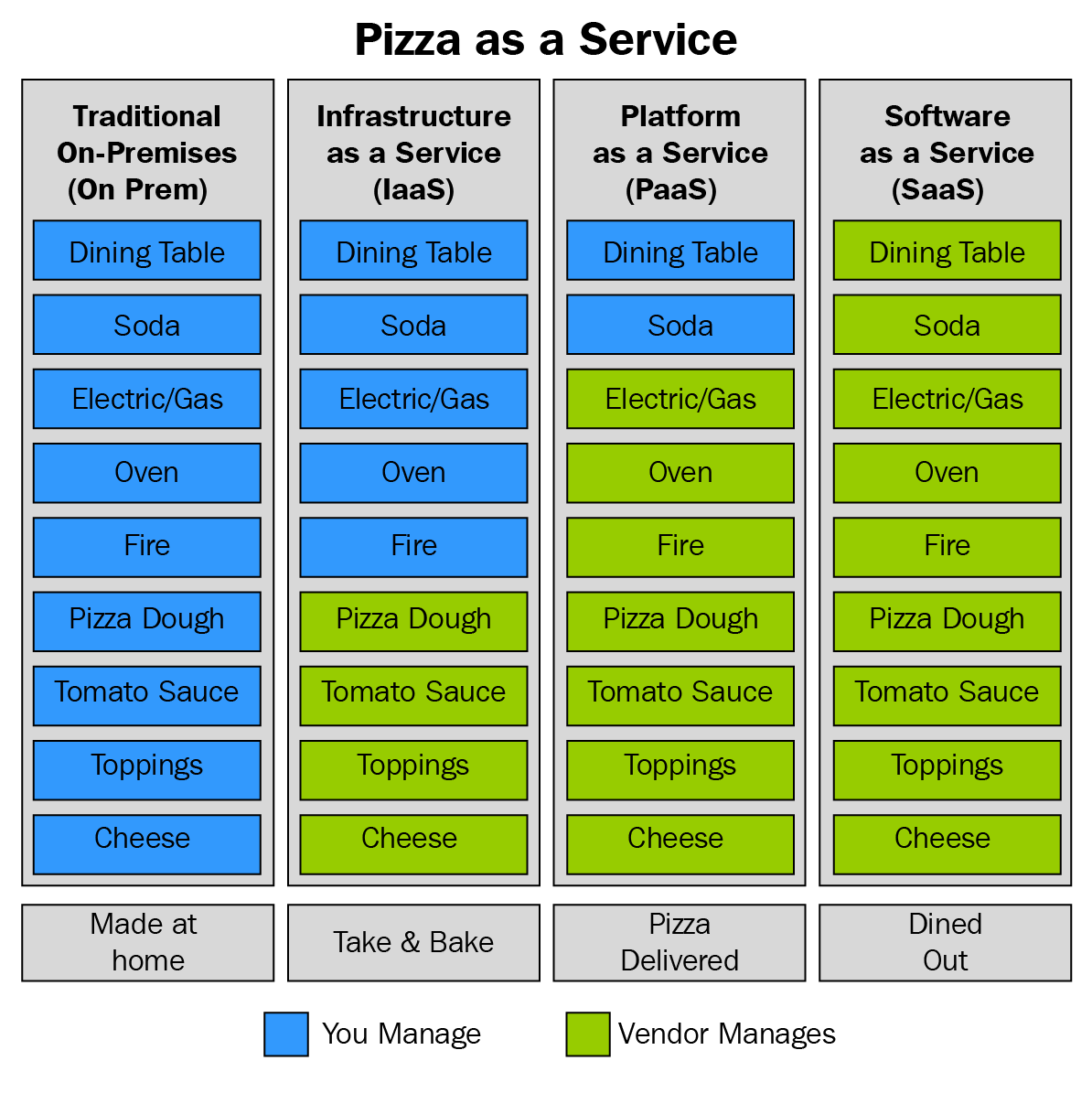Speaking of IaC, we have lot of terms something as something in cloud world. The main types of services in Microsoft Azure (and cloud in general) are:
- Infrastructure as a Service (IaaS)
- Platform as a Service (PaaS)
- Software as a Service (SaaS)
Each type represents a different kind of service level and our control over that resource. To explain each one and how they relate, it's best to compare them to services in our local data center. A service layer for all models is shown in the following diagram and we'll use this to explain the relationship between cloud models:

In a private data center, we are responsible to set up and maintain everything. We need to set up a networking stack, prepare and configure storage, buy and prepare hardware, install software, and configure the virtualization host. Then we need to configure images and servers, and deploy and manage databases. Security is also our concern in all aspects—physical security, network security, host and OS security, and finally application security for all application software running on our servers.
With IaaS, it gets easier. We don't have to prepare anything anymore; all we need to do is sign up for a subscription and create a virtual machine when needed and start using it. The part where we must buy, prepare, configure, and maintain is no longer our concern and the cloud service provider takes care of that, in our case Microsoft with Azure. Preparing images and deployments is also no longer our responsibility. Security is getting easier and physical, network, and host security are handled by Microsoft. We still have a responsibility in the security corner in order to keep our operating system up to date, patched, and secure. Application security is also our responsibility and we need to keep applying the best security practices in order to stay safe and secure. Many people forget that when migrating to the cloud we need to step up security. As the cloud service provider takes care of a big part of security, many get comfortable and relaxed and they neglect the part of security they need to take care of. When moving to the cloud, we need to remember that our resources and applications are publicly exposed and will experience significantly more "attacks" compared to when using on-premises infrastructure. Attacking resources on-premises usually means getting behind a firewall, then breaching the server and getting some data out. Now, many services are accessible over the internet and you need to take care of security better than ever before. The best examples of IaaS, when talking about Microsoft Azure, are Azure virtual machines. Both Windows Server and Linux virtual machines are available in Microsoft Azure. An interesting fact is that, according to information Microsoft released in October 2017, more than 40% of virtual machines in Azure are running Linux.
PaaS is getting even easier to use than IaaS. Everything that we said the cloud service provider is taking care of applies, plus some more. In this type of service, Microsoft is taking care of the operating system, additional software needed, and an additional layer of security. We still need to maintain everything we place there (depending on the PaaS service) and the part of security that remains our problem. Again, people forget that security part very quickly as even more responsibility is on Microsoft. However, IaaS is often used with VPN connections (either point-to-site or site-to-site) and endpoints are not publicly exposed in this case. This is not the case with PaaS, which is more often accessed over the internet. Because of this, we need to take security very seriously unless we want to lose our data or access to our services. The best examples of PaaS in Azure are Azure app service or Azure SQL databases.
Finally, we have SaaS. In SaaS, the cloud service provider is taking care of almost everything, from end to end. In this case, we have a complete solution prepared and all we have to do is create a subscription and assign users different kinds of access. Usually, SaaS has to have modules, an administrator, and a user. The administrator module is used to manage users and access levels; the user module is used to actually use the software feature we subscribed to. Security is also our responsibility, only on the user level, and we need to make sure users are aware that they need to keep their credentials safe and their password strong enough to prevent accounts being brute-forced into. The best example of SaaS in Microsoft Cloud is Office 365.
This diagram explaining Pizza as a Service is very often used to describe how cloud services relate to real-life situations and to better understand what cloud computing offers:

In this case, we can compare pizza to all four types we have in the previous diagram that explains IaaS, PaaS, and SaaS as well as on-premises computing.
When compared to on-premises computing, pizza would be the homemade option. We need to buy all ingredients, mix everything, bake it, buy sodas, and serve. Comparing pizza to IaaS, we would buy frozen pizzas and bake them, set up the table, and serve. Pizza, compared to PaaS, would be home delivery—we just order our pizza and need to buy sodas and serve. Lastly, the SaaS version of pizza would be dining in a restaurant: we go out and order and everything is done for us. We get our pizza, get our sodas, and everything is served.













































































